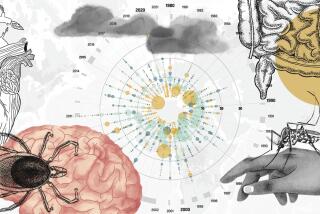INFECTIOUS DISEASES IN THE COUNTY
- Share via
Acquired immune deficiency syndrome (AIDS): a fatal infectious disease that attacks the body’s immune system, leaving a person vulnerable to a variety of life-threatening infections and tumors. AIDS is caused by the human immunodeficiency virus called HIV. The virus is transmitted by sexual contact, exposure to contaminated blood and from an infected mother to her new born.
Campylobacter: usually characterized by sudden, severe acute diarrhea, abdominal pain, fever and vomiting. Most often associated with foods poorly refrigerated or improperly cooked, unpasteurized milk and unchlorinated water.
Lapses of consciousness: impairment of conscious state and responsiveness. Degrees of severity include lethargy, drowsiness, stupor, semicoma and coma.
Giardiasis: a protozoan infection principally of the upper small intestine. While often asymptomatic, it may also be associated with a variety of intestinal symptoms such as chronic diarrhea, abdominal cramps, bloating, frequent loose and pale greasy stools, fatigue and weight loss. The disease is related to drinking tap water. Prevalent in areas with poor sanitation and frequent in day care centers and tour groups.
Gonococcal infections: sexually transmitted bacterial diseases which differ in males and females in terms of course, severity and recognition. The most common are: Urethritis, inflammation of the urethra; Epididymitis, inflammation of that part of the semen-conducting duct which lies upon and behind the testicle; Proctitis, inflammation of membranes of the rectum; Cervicitis, inflammation of the neck of the uterus; Salpingitis, inflammation of one or both fallopian tubes; PPNG (Penicillinase-Producing Neisseria Gonorrhoeae), strains resistant to penicillin.
Gonorrhea: a sexually transmitted venereal disease produced by a sphere-shaped bacteria, affecting genital mucous membranes of either sex.
Hepatitis A: an acute viral illness of worldwide distribution affecting the liver. Occurs mostly in children and young adults. Usually transmitted by oral ingestion of infected material or by poor sanitation conditions.
Hepatitis B: an acute illness of the liver caused by Hepatitis B virus transmitted by exposure to contaminated needles and administration of blood or blood products and/or oral ingestion of contaminated material.
Hepatitis Non-A, Non-B: form of acute viral hepatitis found in people who do not have antibodies to Hepatitis A or B.
Lead poisoning: intoxication from absorption of lead or its salts into the body. Often occurs in young children who nibble on materials containing paint with a lead base. Common signs are abdominal pain, constipation, drowsiness, pallor, mental confusion and a blue line on gums.
Meningitis: inflammation of the three membranes enveloping the brain and spinal chord.
Salmonellosis: a bacterial disease characterized by the sudden onset of a headache, abdominal pain, diarrhea, nausea, vomiting, dehydration and fever. Common cause of food poisoning.
Shigellosis: acute diarrhea acquired by person-to-person contact, through eating contaminated food or handling infected objects. Commonly known as bacillary dysentery.
Streptococcal infection: a sphere-shaped bacteria that grows like chains of little balls. Common cause of strep throat and scarlet fever.
Syphilis: a chronic venereal disease transmitted by sexual intercourse. The first symptom, a chancre, appears after an incubation period of 12 to 30 days, followed by a slight fever.
Tuberculosis: a mycobacterial disease that commonly affects the lungs. General symptoms include sweats, hectic fever and emaciation.
INFECTIOUS DISEASES IN THE COUNTY
NUMBER OF April Current Disease 1988 Year-to-Date Acquired Immune Deficiency Syndrome (AIDS) 20 98 Campylobacter 33 101 Lapse of consciousness (non-alcohol related) 150 592 Lapse of consciousness (alcohol related) 3 9 Giardiasis 32 111 Gonococcal infections 201 937 Gonococcal infections, PPNG 4 16 Gonorrhea 134 610 Hepatitis A (infectious) 42 140 Hepatitis B (carrier) 42 137 Hepatitis, Non A-Non B 15 27 Lead poisoning 14 232 Meningitis 18 66 Salmonellosis 20 107 Shigellosis 18 70 Streptococcal infection 208 799 Syphilis 124 432 Tuberculosis 25 54
CASES Previous Disease Year-to-Date Acquired Immune Deficiency Syndrome (AIDS) 60 Campylobacter 112 Lapse of consciousness (non-alcohol related) 540 Lapse of consciousness (alcohol related) 5 Giardiasis 93 Gonococcal infections 1,363 Gonococcal infections, PPNG 30 Gonorrhea 1,082 Hepatitis A (infectious) 100 Hepatitis B (carrier) 108 Hepatitis, Non A-Non B 17 Lead poisoning -- Meningitis 58 Salmonellosis 88 Shigellosis 63 Streptococcal infection 831 Syphilis 243 Tuberculosis 83
Sources: Orange County Public Health Department, “Reported Cases of Specified Notifiable Diseases,” for April, 1988.
“Control of Communicable Diseases In Man,” Abram S. Benenson, editor, an official report of the American Public Health Assn., 1985, 4th edition.
“Better Homes and Gardens Family Medical Guide,” Donald G. Cooley, editor, 1973, 2nd edition.
“The Bantam Medical Dictionary,” prepared by Laurence Urdang Associates, Ltd., 1982.
“Stedman’s Medical Dictionary,” Williams and Wilkins Company, 1973, 22nd edition.
Chart represents notifiable diseases having 14 or more cases, out of a total of 58 diseases reported weekly to the state by the Orange County Public Health Department for April, 1988.
More to Read
Sign up for Essential California
The most important California stories and recommendations in your inbox every morning.
You may occasionally receive promotional content from the Los Angeles Times.













